Nokia 7600 or a new appearance of the
old phone
Nokia once again proves its successful marketing strategy.
It’s simple; release the phones, when they should be released-
right now, not in the future. Even by releasing the UMTS phone
6650, Nokia kept to their strategy, you can buy this phone
in countries that don’t even have UMTS-networks. A lot of
users choose these types of models because it’s a sign of
prestige, mostly due to the price and amount of the released
handsets. On the other hand, Nokia 6650’s design and size
resulted in poor sales. This is why the 7600 was introduced.
As you’ve already guessed, it’s the same 6650, but in a different
casing. It’s not a smartphone.

The phone looks unusual; almost square, shaped a little
like a water drop. The sides are made a bit oval, which results
in great ergonomics and it fits in your hand nicely. At first
it becomes rather unaccustomed to talk on the phone. Even
though, after using Nokia’s N-Gage this seemed alright. The
size 87õ78õ18.6 mm is not typical for UMTS-phones, although
its capacity remained the same (103 cbcm), this was made possible
due to a new casing. The phone’s weight is typical as well,
123 grams. The 7600 is a little lighter than the 6650, but
the battery also has a smaller capacity. The phone comes in
two colours: yellow and grey.

The keypad is located around the screen with a blue backlight,
giving a futuristic look, however when using it for a while
it gets obvious that it’s not as good as an ordinary keyboard
layout. An almost identical design is used in the smartphone
Siemens SX1.
The speaker is located on the top left corner and the microphone
is on the other side of the phone. The volume control and
IrDA are located on the left side, and the camera- and Power
buttons are on the right side. The Pop-port is located on
the bottom, which is custom.

The TFT screen supports up to 65000 colours, but the picture
looks a lot worse than on Samsung phones because of less saturation
and contrast.

The display’s resolution is 128x160 pixels (32x40 mm),
displaying up to six lines of text, and an extra line is used
for service needs. No changes from previous models with same
amount of colours were made, but the screen’s larger size
allowed the developers to use bigger font, and as a result
readability has greatly improved.

The camera is located on the back of the phone, it’s similar
to the one used in the Nokia 6650 (VGA-resolution).
This model is shipped with a Li-Ion 850 mAh battery. Nokia
claims that the phone will work up to two hours and 20 minutes
when talking, and about 350 hours in standby-mode. We tested
the phone in Moscow, where it worked for about two days with
50 minutes of phone conversation daily, and a minimum amount
of time using the other phone features.
Menu
The introduction of the joystick has led to a new sign
appearing on the screen during stand by mode – Menu, it’s
located in the center of the screen. The left and right soft-keys
are used for the Gallery and Phone book, but they can be changed
to any other functions.
 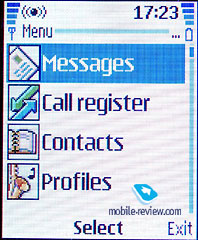

You can access the Phone book, Organizer and Messages with
the help of the joystick by pressing it in the direction you
want. You can’t enable other functions to the joystick which
is disappointing.
The menu looks unusual for Nokia phones – showing a vertical
list of items, with their titles on the right, and it utilizes
more of the screen and seems more convenient to me. You can
navigate with shortcut number navigation. Let’s review the
basic features of the phone.
29mb of memory are dedicated to your needs and it is used
dynamically. (see below)
Phone book. The Phone book features are
similar to the ones of the Nokia 6610 and 6100 etc. Up to
three numbers and one line of text can be added for each entry.
As mentioned above, the memory is used dynamically, which
means that if you have less than 300 numbers, you’ll be able
to save to about 4-5 numbers and 4 text fields for each contact.
Groups are present. You can make 50 voice dials, which works
well.
 
Both the SIM and the phone’s memory can be viewed simultaneously,
with functions for copying entries from SIM to memory and
vice versa.
Messages. The phone can store and send
joined messages (up to 459 characters), and it’s obvious that
Nokia Smart Messaging is supported. T9 can be used while typing
an sms, or if you feel like chatting – use the good old Chat
function.
 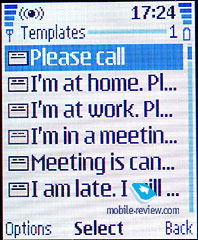
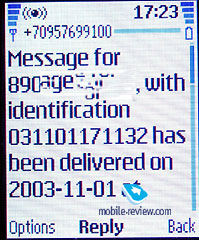 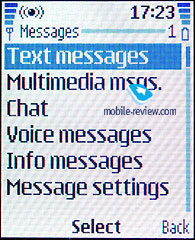
It is possible to create and receive MMS messages.
150 sms and 50 EMS messages can be stored. MMS messages
use the rest of the memory together with Java, ring tones
and images. 10 small images are also preinstalled, just like
templates.
Call list. Consists of a traditional list
of Received, Dialed and Missed calls. Each list can store
up to 20 numbers. The call length and cost is shown here as
well.
Profiles. Nothing extraordinary in this
menu, just activate the profile you want, you can also set
the time for a profile to be active and personalize each of
them.

Settings. From here you can choose wallpaper,
colour schemes, list of shortcuts used for right soft-key
and auto key lock.
 
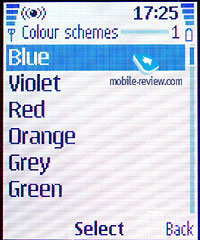
Camera. The built-in camera allows you
to take pictures in VGA resolution and portrait mode (80x96
pixels) and the pictures are stored in JPEG format. When viewing
pictures on the screen the quality is awful, however, after
transferred to a PC they look slightly better, but still not
as good as expected. The camera could be considered as a useless
part of this mobile, since you can’t even set a picture in
a phone book entry (which is pretty basic). The images can
be used only as a wallpaper or an MMS attachment. Three types
of image qualities are available, and despite Nokia claiming
on their website that there is no Night Shot mode supported,
it actually is present.
 
Video clips can be recorded at 15 frames per second with
a maximum length of 2 and a half minutes. The quality is average
and the sound is often out of sync. You can’t really make
good use of this feature.
Gallery. All pictures made by camera,
sound files, and other images are stored here. You have the
ability to create folders which is common.
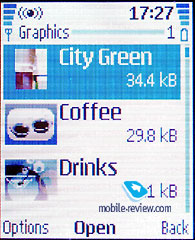 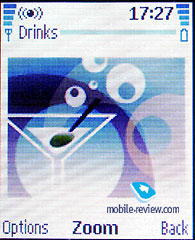
 
Organizer. This feature is similar to
one used in other Nokia phones. You can enter 100 to 500 entries
depending on their length. Automatic deletion of old entries
can be enabled. The Calendar can be viewed monthly and dates
can be accessed as well.
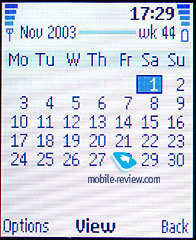 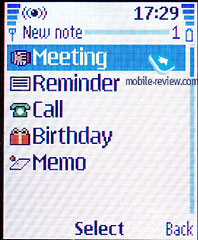
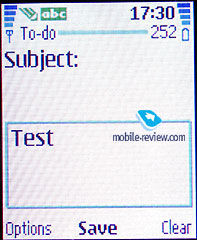 

The To-Do List has the option to set a deadline for each
entry.
The Alarm Clock is simple, you can only set it to a specific
time.
This menu also features a program named ‘Wallet’, where
you can store personal details about credit cards, passwords
etc. and it requires a password to access entries.
Games. The phone doesn’t come with any
games installed, but some of them are located on the CD which
is shipping with the phone. Unfortunately, our package didn’t
have it. Java is supported (MIDP 1.0), so you can download
games or software from the internet.
Applications. A unit converter is the
only preinstalled application.
Extra. Once again, nothing more than a
Calculator, Timer, Stopwatch and settings for Voice Commands.
Connectivity. Settings for GPRS, IrDA
and finally Bluetooth can be found here. The phone worked
with the most of headsets, provided they have the latest firmware
installed.
Services. A WAP browser v2.0 can be accessed
from this menu.
Impressions
Since this phone is the almost identical to the Nokia 6650,
except in a different case, we’ll just repeat the impressions
from 6650. It’s a typical Nokia phone, nothing extraordinary
is featured in this model. It works only in 900 and 1800 MHz
GSM networks with no support for the 1900 MHz which seems
strange. The polyphonic ringtone volume is loud enough, but
the vibrating alert is weak. Surprisingly, you can use the
Dictaphone to record a ringtone (up to 1 minute in length).
Since the phone supports AMR files, you can transfer them
together with messages. The Dictaphone works during both talk
and standby mode.

A lot of features you expect to find in 3G phones are missing.
A mail client or any additional multimedia functions are yet
to be found. Voice marks, Dictaphone and joystick – well,
I guess that’s it on this model.
The new type of display doesn’t look as good as it’s supposed
to, and you just can’t see 65000 colours in it, it looks more
like a great 4096 colour display. The extended memory is dedicated
for the mp3 player, but we get the picture that 29mb is just
not enough for this feature. The quality of the 16-tone polyphonic
ringtones isn’t impressive and is no competition to any Korean
phones.
Considering that the Nokia 7600 is an image phone, there
is no real use in talking about its functions, the main thing
of importance for the consumers is its unusual but nice design.
We expect the phone will be popular mainly among youths and
businessmen who like to stand out from the crowd and feel
different. First shipments will begin in January 2004, the
approximate price will be set at $400-$500, depending on how
consumers will accept the phone.
Sample
ringtones, mp3
|



